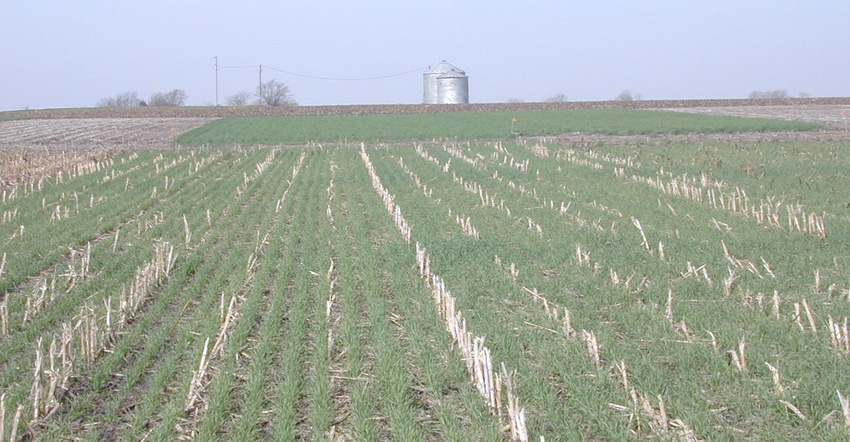January 19, 2017

Nitrogen fertilization is important for achieving high corn yields, with optimal application rates essential for maximizing economic return and minimizing impact on water quality. Winter cereal rye as a cover crop has been shown many times to reduce the concentration of nitrate-N leaving fields in drainage water — a distinct advantage for reducing the environmental footprint of corn and soybean production systems.
A common question is what adjustment should be made to the rate of nitrogen applied for the corn crop that follows winter cereal rye? Because a rye cover crop accumulates plant-available nitrogen from the soil during fall and spring, a related question is whether enough nitrogen is retained that the fertilization rate for corn could be reduced.
Research was conducted in 2009-13 at five Iowa State University Research and Demonstration Farms to study the effect of a winter cereal rye cover crop in no-till corn following soybeans. Rye was drilled after soybean harvest, terminated in the spring with herbicide application (at least seven days before corn planting) and nitrogen (liquid UAN) fertilizer injected within two weeks after planting.
Across the study period, the economic optimum nitrogen rate was found to be similar with or without the rye cover crop (157 pounds of N per acre with rye and 151 pounds of N per acre without rye). The average corn yield was 5% lower following the rye cover crop, 179 bushels per acre with rye and 188 bushels per acre without rye. Why would there be no difference in optimal nitrogen rate with and without the rye cover crop? The main reason is the low rye biomass and concurrent low nitrogen amount.
Across years of the study at each location, the average rye biomass dry matter ranged from 214 to 840 pounds per acre, and total nitrogen in the rye ranged from 8 to 26 pounds N per acre (generally lowest in northwest Iowa and highest in southwest Iowa). These nitrogen amounts, even if all of the rye nitrogen was recycled to the soil as plant-available N for corn uptake, are not large enough to significantly affect the optimal corn nitrogen fertilization rate.
Rye decreases nitrate-N leaching loss
With the low rye nitrogen uptake, how can rye reduce drainage water nitrate-N by 31% as indicated in the Iowa Nutrient Reduction Strategy? We have to remember that the 31% reduction is the percent of the drainage concentration, not a percent reduction of the amount of nitrogen applied to corn.
Assuming the percent nitrate-N concentration reduction equates to load reduction, and assuming 30 pounds nitrate-N per acre is typically lost in drainage water, then the loss reduction is about 9 pounds nitrate-N per acre. That amount is usually less than the rye cover crop nitrogen uptake. Further, the rye nitrogen uptake is during a critical loss period between annual crops. Therefore, a rye cover crop can significantly influence nitrate-N leaching loss, but not the agronomic nitrogen rate.
Higher corn yields with starter fertilizer
Across the years of the study, soybean yields were not affected by the rye cover crop at any location or in any year. However, because producers are concerned about corn yield impacts within a rye cover crop system, and since the nitrogen rate study showed that the yield decline increased with increasing rye biomass amount, a second study was initiated at four of the research sites.
The purpose was to see how starter fertilizer nitrogen (30 pounds N per acre applied 2 inches to the side and 2 inches below the seed, with the remainder of the nitrogen sidedressed) and spring disk tillage (compared to no-till) would impact corn yield (rye was also terminated when small, at 6 to 8 inches).
Corn yield was increased slightly with starter compared to no starter (201 vs. 198 bushels per acre), and corn yield increased slightly with spring tillage compared to no-till (203 bushels per acre vs. 197 bushels per acre). However, spring tillage can offset the erosion protection provided by the cover crop. Overall, there was just a 2% yield difference when corn followed the rye cover crop (202 bushels per acre vs. 198 bushels per acre).
Summing up
Seeding winter cereal rye as a cover crop is an important in-field practice to aid in reducing nitrate-N loss from corn and soybean fields. Soybeans are quite resilient to a rye cover crop, but corn can be more challenging. Corn production practices should be carefully scrutinized when using a rye cover crop to help avoid production issues.
Factors to consider include rye growth amount and termination timing; waiting period for corn planting after rye termination; planting conditions and seed-soil contact; planter setup; applying starter fertilizer when sidedressing the main nitrogen application; recommended nitrogen application rate; and landscape tolerance for tillage so as to not offset erosion control achieved by the cover crop. With active management, cover crops can be successfully integrated into corn-soybean cropping systems.
Sawyer is a professor and soil fertility specialist with Iowa State University Extension. For more information, contact iowalearningfarms.org. Iowa Learning Farms is a statewide conservation outreach program bringing together farmers, landowners, agribusiness, researchers and state and federal agency partners.
About the Author(s)
You May Also Like




